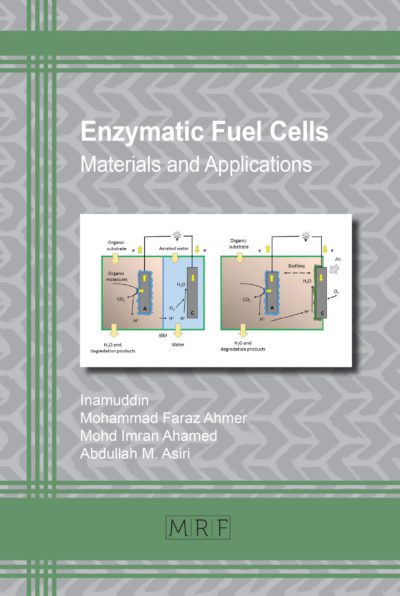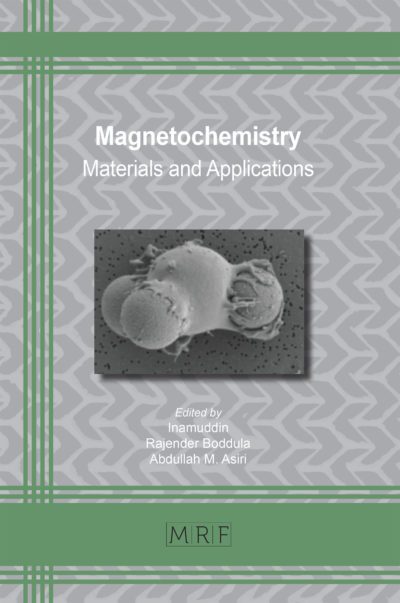Enzymatic Fuel Cells – Materials and Applications
Eds. Inamuddin, Mohammad Faraz Ahmer, Mohd Imran Ahamed, Abdullah M. Asiri
Materials Research Foundations Vol. 44
Publication Date 2019, 166 Pages
Print ISBN 978-1-64490-006-2 (release date February 16th, 2019)
ePDF ISBN 978-1-64490-007-9
DOI: 10.21741/9781644900079
Enzymatic fuel cells, in contrast to conventional energy systems, use enzymes as catalysts for the conversion of chemical energy into electrical energy. These enzymes can also catalyze fuels such as sucrose, fructose and glucose. In addition to their use as catalysts, they are biocompatible in nature. Due to this fact, enzymatic biofuel cells have many interesting applications, such as implantable gadgets (biosensors, pacemakers, catheters, defibrillators, insulin pumps, self-controlled artificial muscles etc.).
The book presents various aspects of biofuel cells including fuel cell electrochemistry, use of enzyme and enzyme immobilization techniques, use of materials such as mesoporous materials, graphene composites, conducting polymer composites and applications of biofuel cells.
Keywords
Fuel Cells, Biofuel cells, Enzymatic Fuel Cells, Enzyme Catalysts, Energy Conversion, Fuel catalysis, Sucrose Fuel, Fructose Fuel, Glucose Fuel, Implantable Gadgets, Biosensors, Pacemakers, Catheters, Defibrillators, Insulin pumps, Artificial Muscles, Mesoporous Materials, Graphene Composites, Conducting polymers, Fuel Cell Electrochemistry, Fuel Cell Applications
Table of Contents
Methods of Enzyme Immobilization on Various Supports
Amna Ahmad, Muhammad Rizwan Javed, Muhammad Ibrahim, Arfaa Sajid, Khadim Hussain, Muhammad Kaleem, Hafiza Mubasher Fatima, Habibullah Nadeem
Use of Enzymes in Different Types of Biofuel Cells
Amna Ahmad, Muhammad Hussnain Siddique, Saima Muzammil, Muhammad Riaz, Ijaz Rasul, Farrukh Azeem, Sabir Hussain, Habibullah Nadeem
Current Advances in Immobilization Techniques of Enzymes
Rajeev Ravindran, Amit K. Jaiswal
Fuel Cell Electrochemistry
Fatma Aydin Unal, Hakan Burhan, Neslihan Karaman, Kubilay Arıkan, Bahar Simsek, Burcu Akyıldız, Fatih Şen
Biological Fuel Cell Applications
Binti Srivastava, Madhu Khatri, Shailendra Kumar Arya
Graphene-based Composites in Enzymatic Biofuel Cells
Mehmet Gülcan, Gulseren Uzun, Buse Guven, Fatih Şen
Mesoporous Materials in Biofuel Cells
Mehmet Harbi Calimli, Mehmet Salih Nas, Hakan Burhan, Fatih Sen
Conducting Polymer-Based Microbial Fuel Cells
Ruchira Rudra, Prasanta Pattanayak, Patit Paban Kundu
Google Preview
LinkedIn Post
https://en.wikipedia.org/wiki/Enzymatic_biofuel_cell














